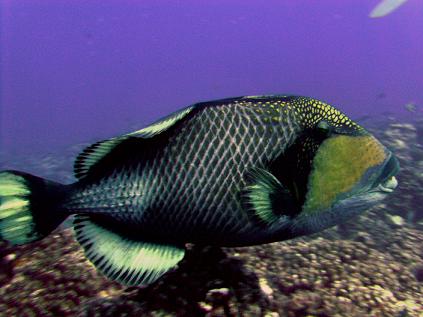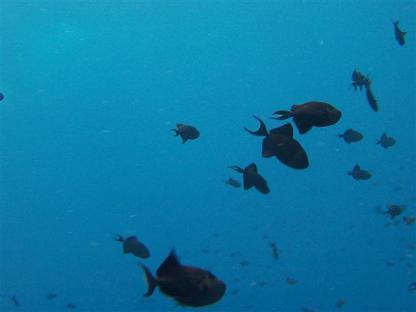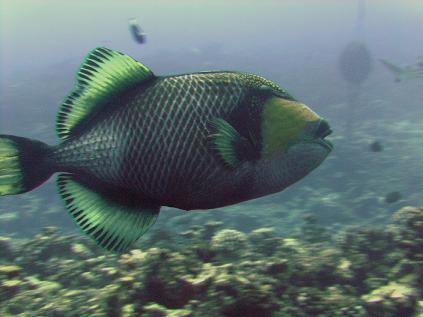
 |
 |
 |
 |
 |
| Home Page | Featured Articles | Awards | Photo Gallery | About Yvonne |
“I faced the animal with upraised, clenched fists, like a boxer. When he came close enough, I shot out a left hook. My gloved fist hit him square on the nose. . No way was I letting him attack me. . . .”
When DAN Referral Physician Pierre Guibor, MD back-rolled into the aquamarine waters off Mabul Island in Malaysian Borneo, the last thing he expected was an underwater boxing match with a fish.
“It was the last dive of my week at Borneo Divers Mabul Resort. We were down around 30 feet exploring a sunken pier a few yards from shore. Visibility was only 45 feet but there was a lot to see. Schools of jacks surrounded us, even let us swim with them. Lionfish lurked in the dark crevices of the pier. My dive buddy had just swum up on a gigantic grouper that must’ve weighed 60-75 pounds. I was keeping an eye out for more fish when I saw something coming at me. I couldn’t believe it. A fish the size of a computer printer was aiming for me!”

Dr. Guibor’s dive group had inadvertently swum near a nesting Titan triggerfish, Balistoides viridescens. The triggerfish perceived the divers as a threat to its eggs and lunged at the first diver it saw, Dr. Guibor. Fortunately, Dr. Guibor had witnessed several previous attacks on divers and was prepared.
“Our first day at Sipadan Island, about 30 minutes from Mabul Island, a triggerfish had bitten a pea-sized hole in my dive buddy Serge’s yellow fin. We laughed it off at the time. But the next day, a triggerfish at a different site off Sipadan Island actually attacked Dieter, another dive buddy. This time the fish drew blood from his right calf area.”
During the surface interval, the Divemaster, Streisand “Strike” Stephen of Borneo Divers Mabul Resort (BDMR) explained the unusual behavior of the yellow margin triggerfish, Pseudobalistes flavimarginatus, about 18 inches (46 cm.) long, that had attacked both Dieter and Serge.

“Triggerfish nest during periods of full moon. The females guard the eggs and will attack anything that swims near. Serge and Dieter didn’t do anything to provoke the attack; they just happened to be in the wrong place at the wrong time.”
Strike cautioned. “Be careful not to swim near the triggerfish when there’s a full moon. That’s when they nest. Usually they ignore us and just poke about the corals. If you notice them shooting back and forth over a patch of coral, then you’re near their nest. Back off.”
Memories of Dieter’s attack flashed through Dr. Guibor’s mind. “I was wearing a 3 mm full wetsuit, unlike Dieter who’d worn a shortie that exposed his bare legs. When the triggerfish started after my fins, I thought he might attack my leg--or private parts.” he added with a wry smile. “This triggerfish was a lot bigger than the ones that attacked Dieter and Serge. Making a run for it seemed to incite the triggerfish to attack harder and more frequent. That’s when I decided not to retreat but to go on the offensive. I turned, faced the attacker directly and started punching.”
Helpless dive buddies stared as the Titan triggerfish, nearly two feet long (60 cm) darted back and forth, trying to nip Dr. Guibor’s black Scuba Pro jet fins. “He—or maybe she--would swim alongside me then come up from the bottom. I got horizontal in the water and put up my fists. I never let my legs get exposed to him and didn’t give him a chance to get my fins. When he was about 10 feet away, he came after me. I yelled, even with the regulator in my mouth. I fought him like a boxer and kept him at bay.”
The triggerfish dodged Dr. Guibor’s blows, delivered with clenched fists encased in tropical neoprene gloves. “I dive with gloves for protection, but never figured I’d be duking it out with a triggerfish.”
Dive buddies tried to kick the fish away but failed. “The fish was too fast,” they ruefully reported.
“When the fish came close enough, I struck, landing a couple of left hooks on his nose. That scared him away but not far enough for me to get away. I swam backwards in a semi-standing position, watching him/her. The triggerfish stayed away for a while, maybe 20 to 30 feet away then returned. He charged. I threw jab after jab, landing two good strikes on his nose. After I hit him the second time, he swam off, but he kept his eye on me. He didn’t come back. And he never bit me.”
Internet chat boards abound with tales of attacking triggerfish (Family: Balistidae), that are found in tropical oceans all over the world including Hawaii, where they are called “humuhumu-nukunuku-a-pua’a.” Eastern US divers may encounter the Gray Triggerfish (Balistes capriscus), found along the “eastern Atlantic coast of the US from Nova Scotia to Bermuda to Argentina including a presence in the Gulf of Mexico and the Caribbean Sea,” (New Jersey Reef News, 2003). Triggerfish are so-called because of “a mechanism that locks the first dorsal spine into position by the second dorsal spine. . .the fish can wedge itself into a rock crevice if threatened. . .” (Allen, 2000) The fish’s “trigger” can also inflict a painful cut on an animal or human that bites or grabs it in that area.
But it’s the triggerfish-to-human bites that fill Internet postings where divers report the majority of bites occurring on exposed skin areas of the legs, hands and head.
Triggerfish are not venomous. But they possess very visible teeth with which to crunch mollusks or corals. (Allen, 2000) Those teeth can puncture skin and draw blood, as Dieter knows well. However, this attack wasn’t Dieter’s first encounter with nesting triggerfish. “I was attacked two years ago, in the Maldives, in February. I saw the nest and two fish taking care of the eggs, which were 5-10 mm. orange balls. When one fish saw me, it attacked my fins but didn’t bite me. The other fish stayed on the nest.
“Also in Maldives, I was snorkeling when I saw a triggerfish attack a diver around his mask. The diver needed a sewing of the wound at the nose. The divers there said the triggerfish are always aggressive in February. And in Maldives I heard the story of ‘Bruno’, a crazy triggerfish who attacked everybody, every time, following far to the deep blue water!”

Triggerfish are colorful critters to watch and photograph. So what should divers and snorkelers do?
First, avoid the nest. “Avoiding triggerfish nesting sites is the best prevention,” believes Dr. Guibor. But do divers know what a triggerfish nest looks like? Look for a “shallow crater about 50-80 cm. in diameter” in “sand or sand rubble substrata near reefs,” with “a pinkish mass at the bottom.” (Millington et al. 1990)
Second, watch the moon. If it’s full, expect the triggerfish to be nesting.
Third, observe triggerfish behavior. Its usual behavior is to nibble on coral, ignoring divers and snorkelers. If instead of eating and ignoring you, they’re facing you or your buddies and darting back and forth, then swim away. Dieter adds, “The locals on Maldives advised that triggerfish defend a cone-shaped area around and above their nests. So if attacked, dive either down, away from the nest, or swim away on the same level as the nest. Never swim straight up because that’s still in their area within the cone.”
If attacked during a safety stop, the diver should avoid diving down. Having already rid his body of accumulated nitrogen, the diver should swim away at the same level as the nest and complete the safety stop as planned, if possible. Reminds Dr. Guibor, who is also a NAUI instructor, “Never panic and bolt for the surface to escape the triggerfish. You may be inviting a long stay in a recompression chamber.”
He adds, “Dive protected. Wear a full wetsuit, booties, and consider a hood and gloves.” He smiles. “One should never box a triggerfish without gloves.”
Dr. Guibor advises, “If superficial, clean the wound with simple soap and water. Apply topical antibiotic ointment and a dressing. With a little nick or scrape I don’t see the necessity in discontinuing your dive day. However, if the bite involves full thickness skin avulsion, this should be treated with appropriate plastic surgery closure, preferably in an operating room or emergency room setting. If closure is not possible, then attempt to close with Steri-strips™. One tape closure would be indicated. Open granulation of the wound may take 4-6 weeks and secondary repair may be required to avoid scar retraction to the underlying muscle.” Looking at a worst case scenario, Dr. Guibor continues, “If a toe were to be amputated with the bite, then emergency evacuation would be indicated for appropriate IV antibiotics, tetanus toxoid booster and microsurgical repair."
Since a triggerfish attack may not occur near your hometown medical center, Dr. Guibor concludes, “Every diver should have DAN Membership/DAN Insurance when diving around the world.”
Dieter, a medical doctor from Germany, and Strike cleaned Dieter’s wound with fresh water and alcohol from the dive boat’s first aid kit. When the blood was wiped off, three sets of detailed circular bite marks showed just lateral of the mid-shaft tibia. It appeared to be a superficial wound with a puncture type injury. Tetanus toxoid was not available.
Even though the bite was no longer bleeding, Dieter and Strike wrapped the bite with a couple of turns of sterile gauze. Dieter dived again that day and the next.
Dieter’s wound appeared to heal quickly. By the third day, it showed only a little erythema with no edema or signs of infection. He flew back to Germany. Eleven days later, he wrote, “The bites are still black-- perhaps necrosis? There is an erythema of 4cm in diameter.” Five months later, however, he reported a “chronic infection of the skin” which was now dark and thin. Currently he is seeking treatment options.
References
Allen, Gerry Marine Fishes of Southeast Asia, 2000.
Millington, J. T. and Randall, J. E Wilderness Medical Journal 1, 1990.
New Jersey Reef News, 2003.
c. DAN ALERT DIVER Magazine
